One of the parts of our Italian road trip this summer that I was most looking forward to was the homemade pasta class. I’ve made handmade pasta before, but never under nonna’s tutelage. More importantly, I’ve yet to perfect my gluten-free pasta skills, and our hosts promised that she could help me do just that.
Given their willingness to accommodate my needs with a gluten-free version, I expected that our villa came equipped with a serious teaching kitchen. Unfortunately, when we arrived, I saw that like generations of Italians before us, we’d simply be sitting around a dining room table as our pasta guide, Isabella, hand mixed 10 pounds of flour and two dozen eggs by hand.
MY LATEST VIDEOS
Every package of flour that she ceremoniously dumped onto the table’s surface, made me feel like I was staring at the onset of Hiroshima’s mushroom cloud. I would say that Charlie was perceptive enough to catch my panic in the confined space. But I think most people noticed me double-wrapping my cotton scarf around my face as a makeshift gasmask. The wooden boards lined in front of us were caked in decades’ worth of paste-y pasta dough residue. And I knew immediately, that I would have to sit this experience out.
In a rare role reversal, Charlie was our kitchen hands, and I was the passive bystander. I stood in the doorway at a safe distance as the participants kneaded their dough and Isabella demonstrated how to turn it into long strands of pici.
Every Italian region has its specialty, and the Tuscan brand of cucina povera revolves around this hand-rolled “fat spaghetti.” Most of the time on menus, you’ll find it tossed with a meat ragu. But at home, if you’re willing to break the rules, it can be tossed with any sauce you like.
The technique for rolling these strands is simple enough, but does require a good amount of dexterity and well-earned muscle memory. I watched as Charlie and many of the others struggled to develop even, thin strands, and I struggled harder trying not to micromanage him or throw caution to the flour-dusted wind and get in there myself.
It’s a motion you have to watch to understand (and one that I hope to eventually turn into a video for you!), but the most essential tactic is to hold the dough in your left hand and use your right for rolling (FYI I didn’t use a tripod in these pics, so don’t mimic my one-handed ways!). You keep your pressure even in the right working hand, and don’t continue down the line of dough until the piece you’re working on is sufficiently thin. Going back on your work usually causes the strands to break and leads to unevenness. The left hand is essential, as you must hold the dough with enough tension to slowly elongate the tube as you roll. A wooden cutting board and damp hands also help immensely.
I eventually got in on the action of pici making on a clean plastic cutting board at a picnic table outside. The brand of gluten-free flour they used was very light and delicate, so much so, that rolling was impossible. I had to slowly shape the strands using both hands and no pulling. What resulted was a thick choker compared to the others’ flapper-length multi-stranded necklaces. But once cooked and in the ragu, it tasted fantastic.
Never one to sit on the sidelines, I was determined upon returning home to figure out a gluten-free version of these homemade thick spaghetti noodles, and to perfect the technique of my Tuscan friends’ continuous roll. More importantly, I wanted to be able to have a recipe to share with you all. Apparently homemade pasta recipes don’t exist in the old country – you have to go on feel!
I’m proud to report that I nailed it on the first try by using Cup4Cup flour, which had a much better elasticity than the Schar I used in Italy. In the process, I became the Aziz Ansari of pici making. I’m very dedicated to my craft!
It might seem like a lot of work for a weeknight, but especially as the weather cools down, there’s no more fun indoor activity than teaching yourself the medatative art of pici. It reminded me a bit of making playdough necklaces in arts and crafts, but with the added benefit of getting to dip them in tomato sauce and call them dinner by the end.
Read on for this gluten-free pasta recipe for Tuscan fat spaghetti noodles, and if you feel like a fun project, I highly recommend slowing your roll and giving it a try.
Also stay tuned for later in the week when I finally post the full itinerary and healthy hedonist guide to Tuscany! My god, is it Tuscany week on Feed Me Phoebe? Certo!
From one healthy, noodle-loving hedonist, to another,
Xoxo
Phoebe
Homemade Gluten-Free Pici Pasta (Tuscan Spaghetti Noodles)
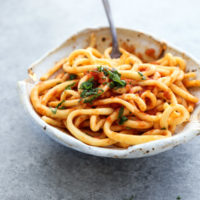
I used Cup4Cup flour and found that it gave the gluten-free strands some nice elasticity. When I was in Tuscany, we used the Schar brand and they broke a lot more easily. Try whatever gluten-free AP flour you have on hand, but if you find the dough is too delicate to roll, you may have to simply shape it into a tube with your hands, and not try to roll and stretch at the same time.
Traditionally, pici is served with a meat ragu (the Tuscan version of a bolognese sauce), but I love it with just a simple marinara or pesto. Use whatever you prefer. For more best practices on cooking gluten-free pasta, click here.
Ingredients
- 1 1/2 cups AP gluten-free flour
- 2 eggs
- 1/2 cup water
- Sea salt
- 2 cups Marinara sauce for serving
- 2 tablespoons chopped basil or parsley for serving
Instructions
-
Place the flour in a large mixing bowl and push up against the sides, creating a well in the center. Crack the eggs into the well, and beat with a fork, slowly incorporating more flour as you mix it together. Add the water, one tablespoon at a time, until the dough is moist and beginning to hold together. It should be the consistency of playdough, with just a few dry crumbs. I used about 1/3 cup total water.
-
With clean hands, knead the dough in the bowl, pushing down and folding the patty back on itself until you have a ball that is more or less smooth in texture. Note: GF doughs will not become elastic in the same way as regular pasta dough. Do not expect to press the dough ball and have it bounce back.
-
Place the dough ball on a clean work surface (preferably a large wooden cutting board with some texture, anchored to the counter with a damp paper towel). Cut the dough into 8 equal pieces. Return to the bowl and cover with a damp kitchen towel while you work through it.
-
Take your first piece of dough and with damp hands, roll it into a thick cylinder (about 5-inches long). The process of rolling out your pici pasta from here requires some dexterity and feel—you’ll get better at it as you go! Hold the dough in your left hand, while using your right hand to roll the right most portion of the log into a thin strand. The thinner, the better. But ideally, you just want the final strand to be as consistent in size as possible so that it cooks evenly. As you roll with your right hand, putting adequate downward pressure on the dough, gently use your left hand to create some friction and elongate the log (the wooden board will help with this – a plastic board will be too slippery). Keep working your way through the dough to the left, draping the finished, thin part of the strand in coils to your right. The key here is not to double back on your work. Make sure the dough you’re working is as thin as possible before proceeding down the rest of the log. If a piece breaks, simply reattach the strand and roll the two together again. By the end, you want your finished strand to be able to circle your neck 5 times as a necklace. Place the coiled noodle on a sheet pan or floppy board and cover with a kitchen towel until you’re finished repeating the process with the remaining pieces of dough.
-
Bring a large pot of water to boil. Once there are bubbles, add a tablespoon or so of salt (it should taste like a well seasoned broth!), and return to a rolling boil. Carefully add the pasta strands, and stir so that the strands separate. Cook, stirring occasionally, until the noodles are tender, about 4 to 6 minutes. (They should float throughout). Drain the pasta and toss immediately with your sauce. Enjoy right away with a garnish of basil or parsley!
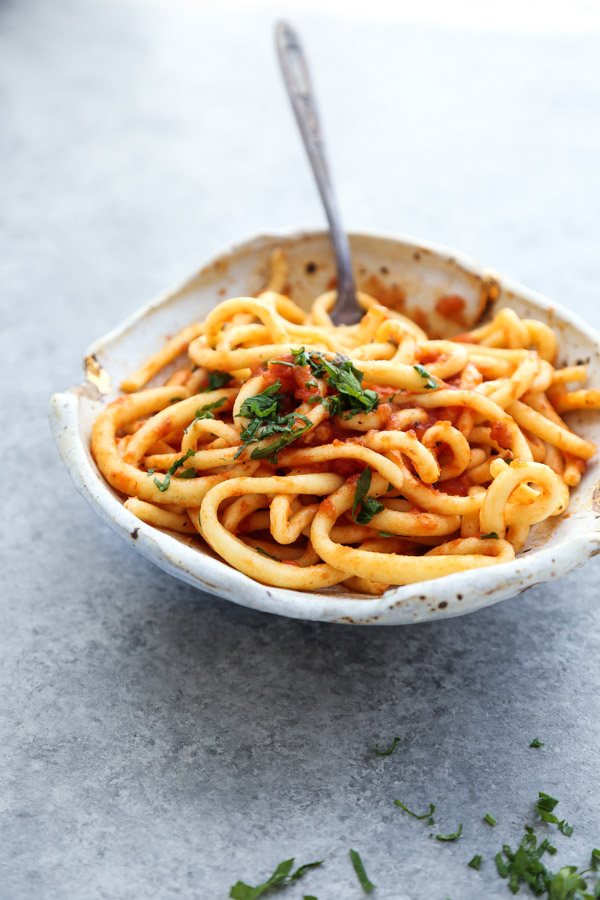



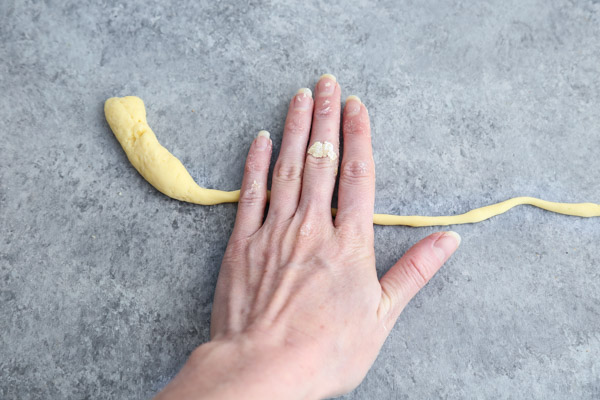
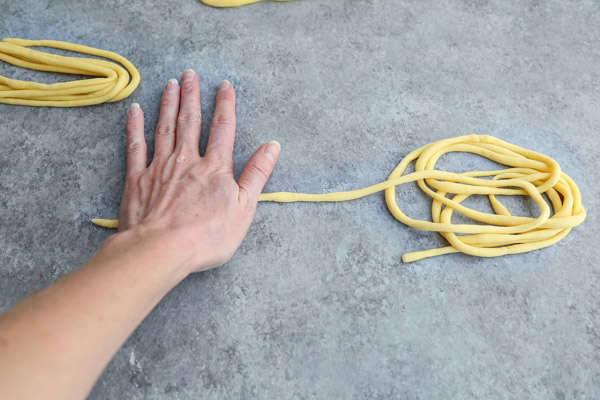
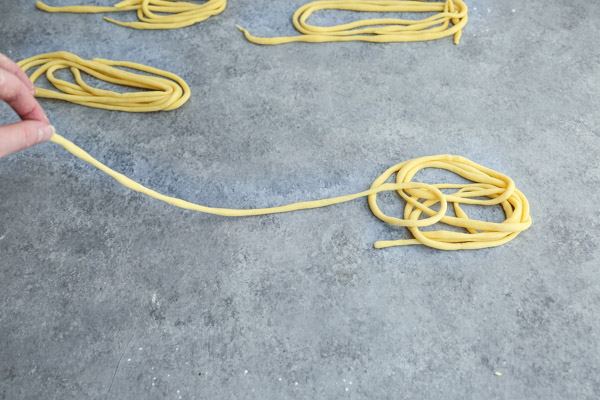

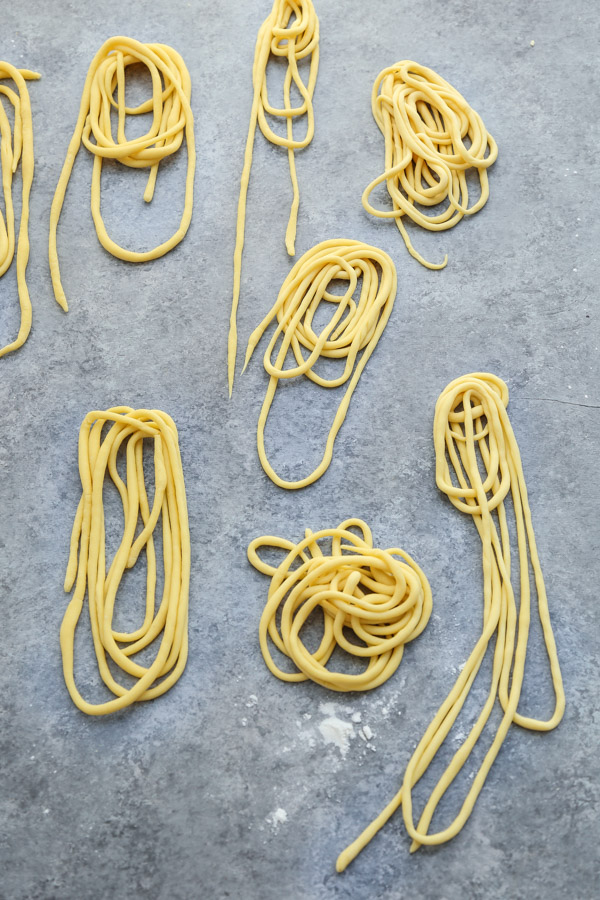

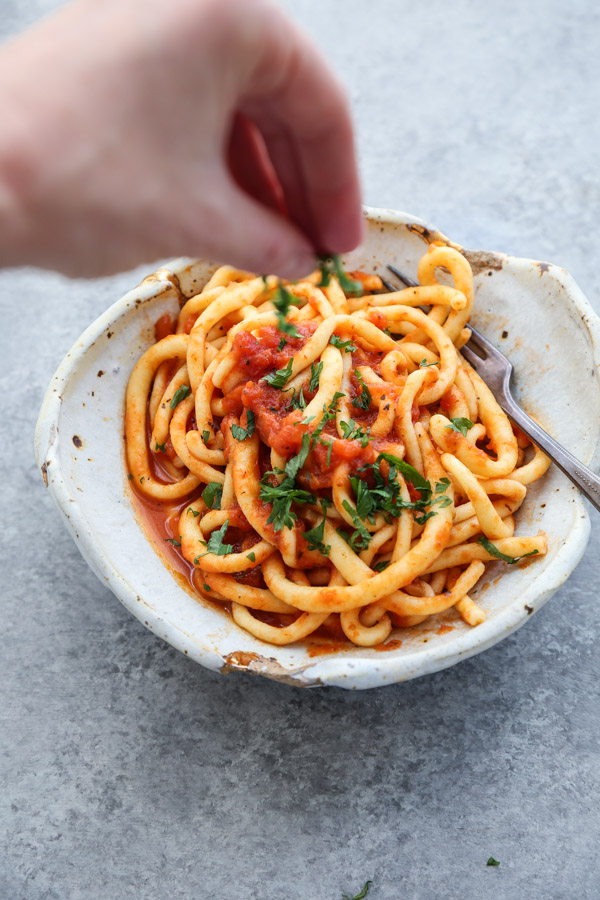

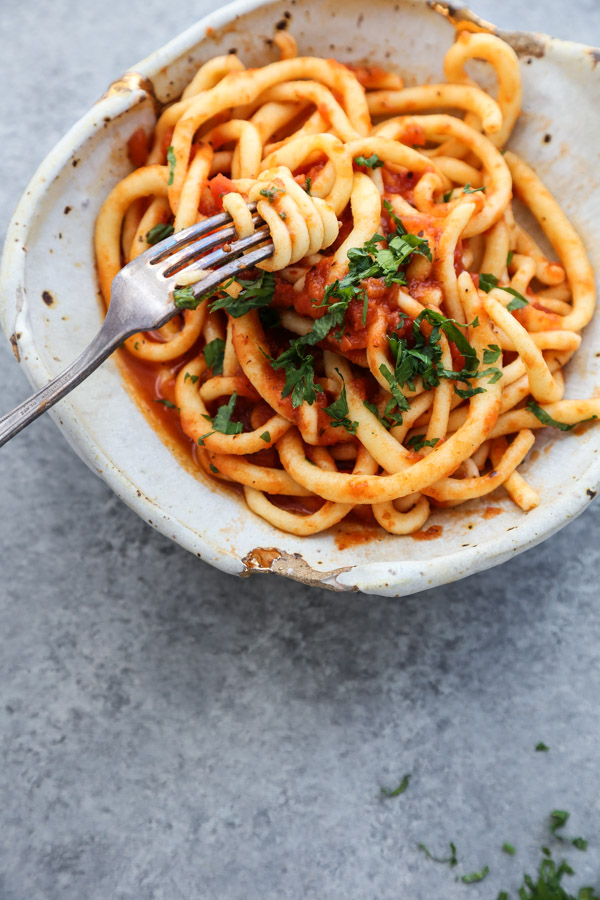
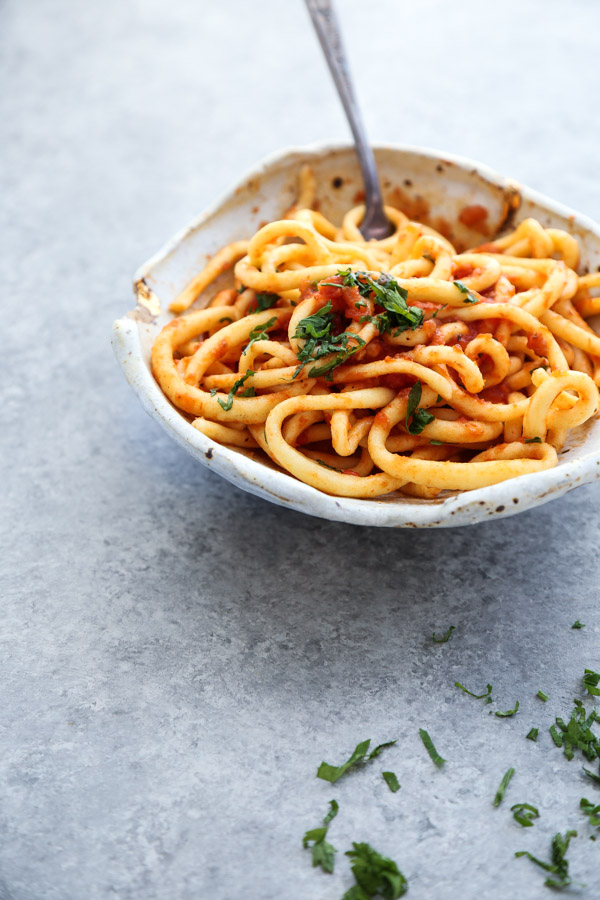
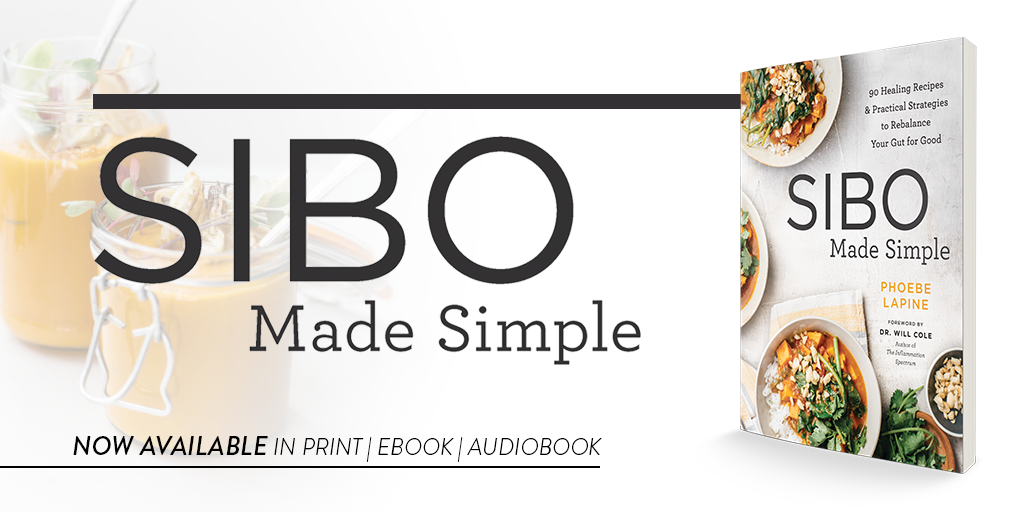
this looks soooo therapeutic. i think i might have to try this the next time i feel nostalgic for play-dough 😉
It really is quite meditative. And also a bicep workout 🙂
Could you use a pasta maker with the Cup4Cupflour?
I can only vouch for this recipe using the hand pulling technique, but I don’t see why it wouldn’t work. Report back!